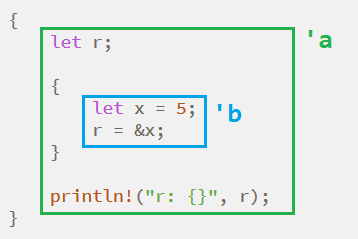Understanding Lifetimes in Rust
The lifetime mechanism in Rust is a resource management system that's just as important as the ownership system.
This concept was introduced primarily to address resource management issues in complex type systems.
References are essential when dealing with complex types, as complex data structures cannot be easily copied and computed by the processor.
However, references often lead to extremely complex resource management issues. Let's first understand dangling references:
{
let r;
{
let x = 5;
r = &x;
}
println!("r: {}", r);
}
This code won't pass the Rust compiler because the value that r references has been deallocated before it's used.

In the above diagram, the green range 'a represents r's lifetime, while the blue range 'b represents x's lifetime. Clearly, 'b is much shorter than 'a, and references are only valid within the lifetime of their values.
We've always used String instead of &str in structures. Let's explain why with an example:
fn longer(s1: &str, s2: &str) -> &str {
if s2.len() > s1.len() {
s2
} else {
s1
}
}
The longer function returns a reference to the longer of two string slices. However, this code won't compile because the return value might reference expired data:
fn main() {
let r;
{
let s1 = "rust";
let s2 = "ecmascript";
r = longer(s1, s2);
}
println!("{} is longer", r);
}
Although the comparison is made, both s1 and s2 are invalid when r is used. We could move r's usage within the lifetime scope of s1 and s2 to prevent this error, but functions can't know about their external context. To ensure the values they pass out are valid, they must eliminate all risks according to ownership principles, which is why the longer function won't compile.
Lifetime Annotations
Lifetime annotations are a way to describe reference lifetimes.
While they don't change the actual lifetime of references, they can declare that two references have the same lifetime where appropriate.
Lifetime annotations begin with a single quote, followed by a lowercase word:
&i32 // Regular reference
&'a i32 // Reference with lifetime annotation
&'a mut i32 // Mutable reference with lifetime annotation
Let's modify the longer function using lifetime annotations:
fn longer<'a>(s1: &'a str, s2: &'a str) -> &'a str {
if s2.len() > s1.len() {
s2
} else {
s1
}
}
We need to use generic declarations to standardize lifetime names. The function's return value lifetime will match both parameters' lifetimes, so we can write the call like this:
fn main() {
let r;
{
let s1 = "rust";
let s2 = "ecmascript";
r = longer(s1, s2);
println!("{} is longer", r);
}
}
Output of the combined program:
ecmascript is longer
Note: Don't forget the principle of automatic type inference.
Using String Slice References in Structures
Here's the answer to our previous question:
fn main() {
struct Str<'a> {
content: &'a str
}
let s = Str {
content: "string_slice"
};
println!("s.content = {}", s.content);
}
Output:
s.content = string_slice
If we define methods for the Str structure:
impl<'a> Str<'a> {
fn get_content(&self) -> &str {
self.content
}
}
Here, the return value doesn't have a lifetime annotation, but adding one wouldn't hurt. This is a historical issue - early Rust didn't support automatic lifetime inference, requiring strict lifetime declarations, but current stable versions of Rust support this feature.
Static Lifetime
There's a special lifetime annotation: 'static. All string literals enclosed in double quotes have the exact data type &'static str. The 'static lifetime represents the entire duration of the program, from start to finish.
Combining Generics, Traits, and Lifetimes
use std::fmt::Display;
fn longest_with_an_announcement<'a, T>(x: &'a str, y: &'a str, ann: T) -> &'a str
where T: Display
{
println!("Announcement! {}", ann);
if x.len() > y.len() {
x
} else {
y
}
}
This code, from the Rust Bible, demonstrates a program that simultaneously uses generic types, traits, and lifetime mechanisms. While it's not mandatory to understand right away, it's worth familiarizing yourself with it as you'll eventually need these concepts!